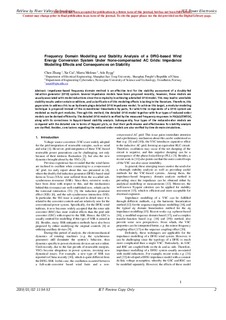Frequency Domain Modelling and Stability Analysis of a DFIG-based Wind Energy Conversion System Under None-compensated AC Grids: Impedance Modelling Effects and Consequences on Stability
Journal article, Peer reviewed
Accepted version
Permanent lenke
http://hdl.handle.net/11250/2579321Utgivelsesdato
2019Metadata
Vis full innførselSamlinger
Originalversjon
10.1049/iet-pel.2018.5527Sammendrag
Impedance-based frequency domain method is an effective tool for the stability assessment of a doubly-fed induction generator (DFIG) system. Several impedance models have been proposed recently, however, these models are usually associated with model reductions since the complexity in achieving a detailed DFIG model. This may lead to unreliable stability results under certain conditions, and a clarification of this modeling effects is lacking in the literature. Therefore, this paper aims to address this issue by developing a detailed DFIG impedance model. To achieve this target, a modular modeling technique is proposed instead of the conventional linearization by parts, for which the components of a DFIG system are modeled as multi-port modules. Through this method, the detailed DFIG model together with four types of reduced-order models can be derived efficiently. The detailed DFIG model is verified by the measured frequency responsesin PSCAD/EMTDC, along with its correctness in Nyquist-based stability analysis. Subsequently, four types of the reduced-order models are compared with the detailed one in terms of Nyquist plots, so that their performance and effectiveness for stability analysis are clarified. Besides, conclusions regarding the reduced-order models are also verified by time domain simulations
